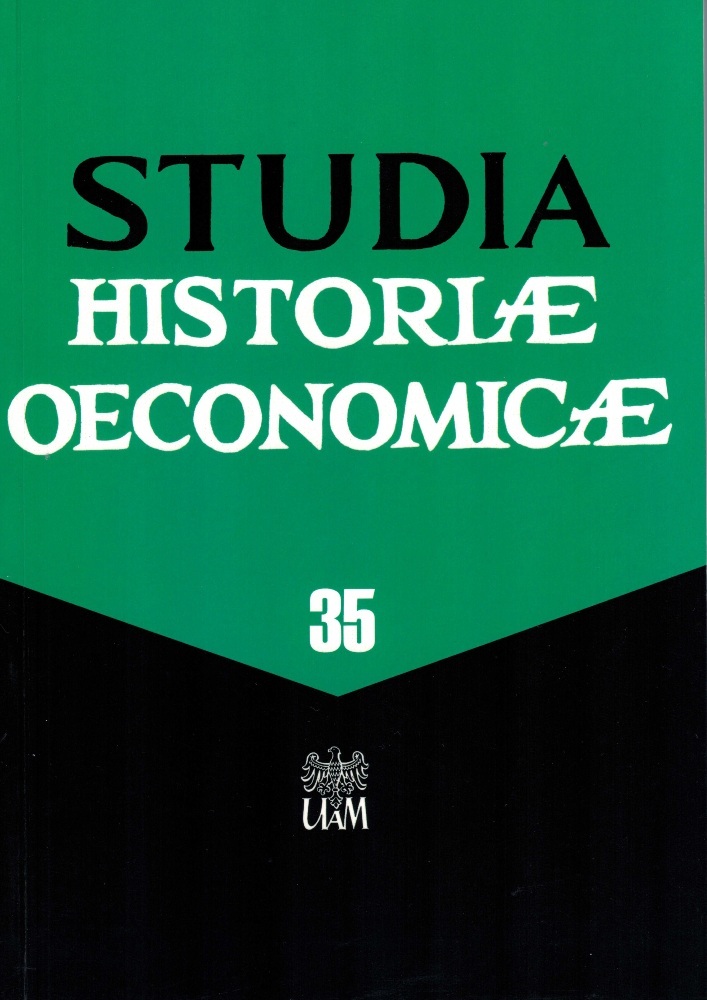Abstract
The article presents how DEA is used to develop agricultural production efficiency rankings in the EU member states, which can be used as the starting point for evaluating the performance of currently used instruments of economic policy. In the article, statistical data from the FADN were used. Agricultural production was compared for three types of output and four types of input involved. The performed study demonstrated that in 18 out of 28 states, agricultural production had been run efficiently on a macro level. The applied approach also allowed for identifying the causes of inefficiency in the remaining ten states, providing indications for recommended changes in in the way economic instruments are used.
References
Ackrill R. (2000), The Common Agricultural Policy, Sheffield Academic Press, Sheffield.
Afriat S.N. (1972), Efficiency estimation of production functions, “International Economic Review” no. 13, p. 568-598.10.2307/2525845Open DOI.
Aigner D.J., Chu S.F. (1968), On estimating the industry production function, “American Economic Review” no. 58, p. 826-839.
Błażejczyk-Majka L. (2016): Polskie gospodarstwa mleczne w rankingu efektywności technicznej gospodarstw unijnych z wykorzystaniem modelu SE-CCR [Polish Dairy Farms in the Ranking of Technical Efficiency of EU Farms Using the SE-CCR Model]. „Problemy Rolnictwa Światowego” [Problems of World Agriculture], no. 16 (XXXI), issue 3, p. 20-34.
Charnes A., Cooper W.W., Rhodes E. (1978), Measuring the efficiency of decision-making units, “European Journal of Operational Research” no. 2, p. 429-444.10.1016/0377-2217(78)90138-8Open DOI.
Coelli T.J., Rao D.S.P., O’Donnell C.J., Battese G.E. (2005), An Introduction to Efficiency and Productivity Analysis (second eds.), Springer Science+Business Media, New York.
Ćwiąkała-Małys A., Nowak W. (2009), Sposoby klasyfikacji modeli DEA [Methods of classifying DEA models], “Badania Operacyjne i Decyzje” [Operational research and decisions], no. 3, p. 5-18.
Debreu G. (1951), The coefficient of resource utilization, “Econometrica” no. 19, p. 14-22.10.2307/1906814Open DOI.
Farrell M.J. (1957), The measurement of productive efficiency of production, “Journal of the Royal Statistical Society, Series A” no. 120(III), p. 253-281.
Førsund F.R., Sarafoglou N. (2002), On the origins of data envelopment analysis, “Journal of Productivity Analysis” no. 17, p. 23-40.
Fried H., Lovell K., Schmidt S. (2008), Efficiency and productivity, [in:] Fried H., Lovell K., Schmidt S. (ed.), “The Measurement of Productive Efficiency and Productive Growth”, Oxford University Press, Oxford-New York.
Guzik B. (2009a), Podstawowe modele DEA w badaniu efektywności gospodarczej i społecznej [Basic DEA models in the assessment of economic and social efficiency], Wydawnictwo Uniwersytetu Ekonomicznego w Poznaniu, Poznań.
Guzik B. (2009b), Podstawowe możliwości analityczne modelu CCR-DEA [Basic analytical capabilities of the CCR-DEA model], “Badania Operacyjne i Decyzje” [Operational research and decisions], no. 1, p. 55-75.
Koopmans T.C. (1951), An analysis of production as an efficient combination of activities, [in:] Koopmans T.C. (ed.), “Activity Analysis of Production and Allocation”, Cowles Commission for Research in Economics Monograph no 13, Wiley, New York.
Lisowski M. (2014), Metoda Data Envelopment Analysis (DEA) w ocenie efektywności podmiotów [Data Envelopment Analysis in the assessment of efficiency], “Prace Naukowe Uniwersytetu Ekonomicznego we Wrocławiu no. 343. Modele zarządzania kosztami i dokonaniami”, [Publications of the Wrocław University of Economics, no. 343, Models of cost and achievement management], p. 364-375.
Löthgren M., Tambour M. (1999), Productivity and customer satisfaction in Swedish pharmacies: A DEA network model, “European Journal of Operational Research” no. 115, p. 449-458.
Rembisz W., Sielska A. (2012), Mikroekonomiczna funkcja produkcji - właściwości analityczne wybranych jej postaci [Microeconomic function of the production - analytical properties of its selected forms], Vizja Press & IT, Warszawa.
Scippacercola S., Sepe E. (2014), Principal component analysis to ranking technical efficiencies through stochastic frontier analysis and DEA “Journal of Applied Quantitative Methods” no. 9(4), p. 1-9.
Świtłyk M. (1999), Zastosowanie metody DEA do analizy efektywności gospodarstw rolnych [Application of the DEA method to analyze the efficiency of agricultural holdings], “Zagadnienia Ekonomiki Rolnej” [Issues of agricultural management], no. 6, p. 28-41.
Thanassoulis E., Portela M., Despić O. (2008), Data envelopment analysis: the mathematical programming approach to efficiency analysis, [in:] Fried H., Lovell K., Schmidt S. (ed.), “The Measurement of Productive Efficiency and Productive Growth”, Oxford University Press, Oxford-New York.
Wroński P. (2011), Wykorzystanie analizy taksonomicznej do opracowania ranking miast Lubelszczyzny [Application of taxonomic analysis to develop the ranking of towns in Lublin region], “Prace Naukowe Uniwersytetu Ekonomicznego we Wrocławiu. Ekonometria (34)” [Publications of the Wrocław University of Economics in Wrocław. Econometrics (34), no. 200, p. 38-47.
Zhang W. (2015), The Analysis of the Agriculture Input and Output Efficiency Based on DEA Model, “Agricultural Science & Technology” no. 16 (2), p. 414-416.
Common Agricultural Policy in figures, downloaded November 2017 from http://www.europarl.europa.eu/atyourservice/pl/displayFtu.html?ftuId=FTU_5.2.10.html.
CEPA (2016). Center for Efficiency and Productivity Analysis. Downloaded March 2016 from http://www.uq.edu.au/economics/cepa/index.php.
FADN (2015). Farm Accountancy Data Network. Downloaded July 2015 from http://www.ec.europa.eu/agriculture/rica.
License
Copyright (c) 2021 Lucyna Błażejczyk-Majka

This work is licensed under a Creative Commons Attribution-ShareAlike 4.0 International License.





